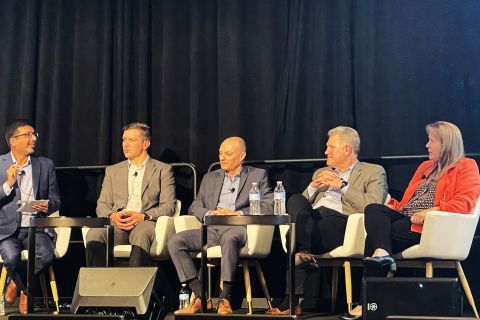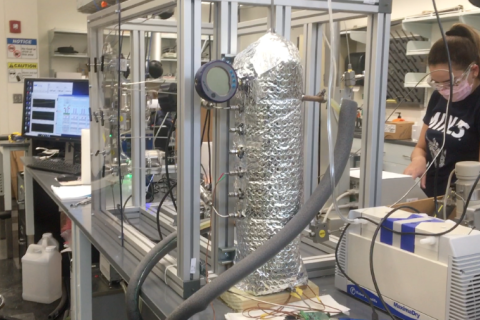"The Haynesville requires very deep pockets," that according to Shannon Nome and Patrick Johnson, research analysts with Deutsche Bank in a 46-page report titled "From Shale to Shining Shale: A primer on North American natural gas plays published last week. At $6- to $7 million per well, the cost of drilling up a sizeable acreage position quickly exceeds a smaller player's ability to fund. "For this reason, we believe M&A and/or ongoing joint venture announcements will be prevalent, as larger, better-funded entrants seek to consolidate positions within the play, or to initiate footholds outright." Using Chesapeake Energy as an example, the analysts forecast the company will require more than 5,000 wells to fully develop its current 440,000-net-acre position on 80-acre spacing. With a 60-rig all-out program, it will take some $35 billion and 15 years to drill out this position---before considering additional outlays for leasehold or infrastructure. Says Nome, "Given the steep financial requirements, but also the massive reserves potential and production ramifications, we believe a play of this scale is sufficiently large to attract the attention of a major integrated company, and would therefore not be surprised to see future joint venture and/or M&A announcements along those lines." Like Shell did in the Montney, announcing last week they intend to buy Duvernay in one big cash chunk. Or BP taking a big Woodford position from Chesapeake days later for $1.75 billion---the "high end" of expectations, according to the DB analysts. Are the majors on the move? Are they coming to Haynesville? They surmise Shell and ExxonMobil at least have "starter" stakes in the Haynesville, to which I can confirm at least for Shell for some family acreage in the southern part of the play they leased for $125/acre two years back. I doubt if they knew about Haynesville then, so just count them lucky. Nome and Johnston conclude, "While these sophisticated, yet large and less-nimble entities clearly have the financial and technical resources to be a dominant force in domestic shale plays, to date it has been the independents leading the way. However, as more datapoints unfold with respect to the Haynesville in particular, the true financial requirements begin to beg questions as to whether this will finally be the catalyst to get the majors interested in scaling back up investment in the U.S. after decades of downscaling." While I agree the majors may be waiting and watching for a chance to step in with a big foot, I wouldn't count on Chesapeake being the bait. More likely it would rather be the Big Fish in the Haynesville food chain, as it is selling and pawning everything in sight to get cash to buy more and drill more (read more in Editor's Commentary in this month's A&DW Watch). Chesapeake started the consolidation by JV'ing with Goodrich Resources then---bam---with Plains Exploration. Petrohawk, too, is in the consolidation game with a JV with Mainland Resources. I predict five players in the Haynesville: Chesapeake/Plains, EnCana, Petrohawk, Devon from behind, and Forest as a darkhorse (I just think they have the hudspah to do it). Everybody else will be dealing. But will Shell grab up the loose pieces? Steve Toon, Editor, A&D Watch; Contributing Editor, Oil and Gas Investor; www.OilandGasInvestor.com; stoon@hartenergy.com
Recommended Reading
Haynesville’s Harsh Drilling Conditions Forge Tougher Tech
2024-04-10 - The Haynesville Shale’s high temperatures and tough rock have caused drillers to evolve, advancing technology that benefits the rest of the industry, experts said.
Fracturing’s Geometry Test
2024-02-12 - During SPE’s Hydraulic Fracturing Technical Conference, industry experts looked for answers to their biggest test – fracture geometry.
Defeating the ‘Four Horseman’ of Flow Assurance
2024-04-18 - Service companies combine processes and techniques to mitigate the impact of paraffin, asphaltenes, hydrates and scale on production — and keep the cash flowing.
Going with the Flow: Universities, Operators Team on Flow Assurance Research
2024-03-05 - From Icy Waterfloods to Gas Lift Slugs, operators and researchers at Texas Tech University and the Colorado School of Mines are finding ways to optimize flow assurance, reduce costs and improve wells.
Drilling Tech Rides a Wave
2024-01-30 - Can new designs, automation and aerospace inspiration boost drilling results?





